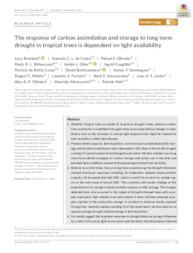The response of carbon assimilation and storage to long-term drought in tropical trees is dependent on light availability.
The response of carbon assimilation and storage to long-term drought in tropical trees is dependent on light availability.
Author(s): ROWLAND, L.; COSTA, A. C. L. da; OLIVEIRA, R. S.; BITTENCOURT, P. R. L.; GILES, A. L.; COUGHLIN, I.; COSTA, P. de B.; BARTHOLOMEW, D.; DOMINGUES, T. F.; MIATTO, R. C.; FERREIRA, L. V.; VASCONCELOS, S. S.; S. JUNIOR, J. A.; OLIVEIRA, A. A. R.; MENCUCCINI, M.; MEIR, P.
Summary: Whether tropical trees acclimate to long‐term drought stress remains unclear. This uncertainty is amplified if drought stress is accompanied by changes in other drivers such as the increases in canopy light exposure that might be induced by tree mortality or other disturbances. Photosynthetic capacity, leaf respiration, non‐structural carbohydrate (NSC) storage and stomatal conductance were measured on 162 trees at the world's longest running (15 years) tropical forest drought experiment. We test whether surviving trees have altered strategies for carbon storage and carbon use in the drier and elevated light conditions present following drought‐related tree mortality. Relative to control trees, the surviving trees experiencing the drought treatment showed functional responses including: (a) moderately reduced photosynthetic capacity; (b) increased total leaf NSC; and (c) a switch from starch to soluble sugars as the main store of branch NSC. This contrasts with earlier findings at this experiment of no change in photosynthetic capacity or NSC storage. The changes detected here only occurred in the subset of drought‐stressed trees with canopies exposed to high radiation and were absent in trees with less‐exposed canopies and also in the community average. In contrast to previous results acquired through less intensive species sampling from this experiment, we also observe no species‐average drought‐induced change in leaf respiration. Our results suggest that long‐term responses to drought stress are strongly influenced by a tree's full‐canopy light environment and therefore that disturbance‐induced changes in stand density and dynamics are likely to substantially impact tropical forest responses to climate change. We also demonstrate that, while challenging, intensive sampling is essential in tropical forests to avoid sampling biases caused by limited taxonomic coverage.
Publication year: 2021
Types of publication: Journal article
Unit: Embrapa Eastern Amazon
Observation
Some of Embrapa's publications are published as ePub files. To read them, use or download one of the following free software options to your computer or mobile device. Android: Google Play Books; IOS: iBooks; Windows and Linux: Calibre.
Access other publications
Access the Agricultural Research Database (BDPA) to consult Embrapa's full library collection and records.
Visit Embrapa Bookstore to purchase books and other publications sold by Embrapa.

